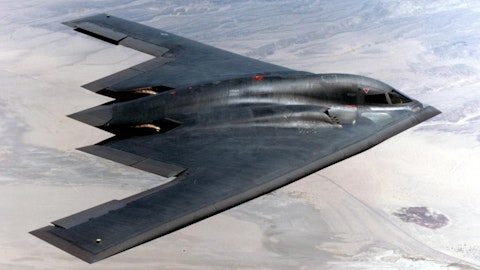Of course, in enterprise and federal, it’s somewhere in between where we might not exactly sell some version of the OSP that we sell to domestic, but it might be some more tailor-made software offerings that are the right fit for those customers. And so for us I think, we always end in the same place, which is highly valuable, highly useful, high ROI software being deployed to customers that remain happy with it. It’s just a question of the path that it takes to get there, and in each segment it might be slightly different. And so that’s a bit of a summary for you.
Brittany Bagley: Yeah, and Will, just on the commentary, I would say I was highlighting T10 and software particularly as drivers for improving gross margins. They obviously both will be great contributors to our revenue next year, but really all of our segments are performing incredibly well and they’ll all contribute really nicely next year.
Will Power: Got it. Thank you.
Erik Lapinski: Thank you, Will. We’re going to take our next question from Alyssa Shreves at Barclays. I think she’s dialed in.
Rick Smith: Looks like she might be muted as well.
Erik Lapinski: Oh, we’re off mute.
Alyssa Shreves: Can you hear me?
Erik Lapinski: We can.
Alyssa Shreves: Great. Good afternoon, guys. Just a kind of quick question on the T10 demand. Is it — are you seeing existing customers looking to upgrade? Is it penetration into new markets? And how much is this VR training kind of moving the needle in terms of T10 adoption? Thanks.
Josh Isner: Yeah, it’s a fantastic question. Thank you very much. This first answer is kind of yes to both. I think our existing customer base is very predictably upgrading, not only at the end of their useful life of their previous generation weapon, but for the first time we’re seeing customers expressed an interest in an early upgrade to TASER 10. So we’re really encouraged by that. Additionally, this is — we do believe this will open new customer markets for us internationally and in some private security and federal use cases as well. And so across the board, very bullish on T10 adoption and the rate at which that adoption is occurring. So that’s a little bit about the market kind of response to T10. Can you just remind me what the second portion of that question was?
Alyssa Shreves: Yeah, how much of the VR training is kind of driving customer interest? Is it more nice to have or are customers kind of viewing this now as a need to have once they trial it?
Josh Isner: I’d say we’re probably squarely in the middle of those two at the moment. And this is a big year for our VR program, because now that the sensors work very well and very reliably, it’s about how much content we can build to deliver to these end users to simulate different training scenarios. So it’s a move from hey how are you performing with T10 at a range setting or some basic interactions and we’ll build on that to these more complicated decision-making types of scenarios. So we think this is going to go hand in hand. Not only, of course, the training experience, if it’s very strong, will help adoption of the product, but it’ll also drive far safer outcomes in the field. If we’re able to simulate the type of stress that you can feel in VR relative to shooting at people in costume or with Velcro suits on or at stationary targets at a range, these are the things that can really make the difference in the field.
And so very excited about that. We’re rolling it out to international as well. We’re rolling it out to federal. We’re tailoring scenarios for those markets. So we think these two products, VR and TASER 10 are kind of linked moving forward. And it’s represented by the way we go to market as well where you pay one rate for both of those offerings and you get both throughout the term of the contract.
Alyssa Shreves: Great. Thank you so much.
Josh Isner: You got it.
Erik Lapinski: Thank you, Alyssa. We’ll take our next question from Mike Ng at Goldman Sachs.
Mike Ng: Great. Good afternoon. Thank you very much for the question. I just have two. First, there was the big step-up in future contracted revenue. I think that $1.3 billion sequential increase is the biggest on record. Is there anything to call out as it relates to outsized deals or customer wins that contributed to that, or would you guys consider that normal momentum? And then I have a quick follow up.
Josh Isner: For sure. I don’t think there was anything abnormal about Q4 other than it was a record quarter for us. And there is some seasonality in our business. It was our first quarter of $1 billion plus dollars booked across the business in five year booking. So we’re really excited about that. We don’t necessarily share much more than that on our total bookings, but that was a pretty big milestone for our team. So of course that’ll represent itself in future contracted revenue and we’re excited about that trend and certainly aiming to outperform that record this year.
Mike Ng: Great. And then just a follow-up for Brittany, just on that future contracted revenue, I know you guys have talked about 15% to 25% of that being recognized in the next 12 months. But I guess as the duration of that future contracted revenue extended at all, have there been longer-term deals? Naturally, the reason why I ask is it seems like you know 25% percent of $7.1 billion, you have full visibility into the 2024 revenue guidance. I don’t know — I’m not sure if that’s the right way to think about it. Thank you.
Brittany Bagley: Yeah, of course it’s a great question. It hasn’t changed such that, that 15% to 25% percent guidance of what converts for the next year has been pretty consistent over at least the last few quarters. I think in general we have seen a trend towards some longer contracts. So again, Josh, Josh will correct me, but I think historically there were more five year contracts and now we’re seeing more 10-year contracts and some that are even longer than 10 years. So that’s certainly a factor in there. But nothing has massively changed in terms of how that future contracted revenue converts in for the next year. I do think it helps in terms of us having visibility and giving a strong guide for next year. And so I think that’s where you see some of that come through.
Mike Ng: Excellent. Thank you, Josh. Thank you, Brittany.
Erik Lapinski: Thanks, Mike. We’re going to go to Josh Riley at Needham next.
Josh Riley: All right. Thanks for taking my questions. I got one and a quick follow-up here. If you look at the Fusus acquisition, is this a product that is going to require a little bit of incremental investment on your part to kind of drive broad customer adoption across the customer base or is this ready to go day one for your entire customer base?
Josh Isner: Yeah, I’ll take that. The good news is, it’s a combination of the two. So right now out of the gate, one of the reasons why we were so excited about Fusus as a partner and then moving to the acquisition is that their product turnkey out of the box today is ready to go very broadly across state, and local in the US and then beginning internationally as well. It’s absolutely a groundbreaking change for the ability for agencies with their real-time crime centers and command staff and even right in the dispatch center to get unparalleled situational awareness by partnering with CCTV cameras from [enterprise] (ph) and the like. So right out of the box, it is just selling and growing like gangbusters. And it’s a fundamental part as we go forward of our overall real-time operations vision you’ve heard us talk about for a long time where our real strategy is to provide the best full stack and open ecosystem we can to help agencies with the entire lifecycle of an incident.
And it’s ultimately about our play to earn the right to win more sockets, meaning win more sensors, and win that pane of glass where they review the information from those sensors, and to win more and more communications moments as both first responders and the businesses where things happen work together to resolve as quickly as possible things when they occur.
Josh Riley: Got it, that’s helpful. And then just a quick follow-up on the TASER 10 automation. Is that going to also benefit unit growth in addition to benefiting margins?
Brittany Bagley: I would say it does, yes. The more automation we have, the more it helps our capacity. I would say that’s pretty much factored in as we think about next year though. So I wouldn’t necessarily expect any surprises coming from that.
Josh Riley: Got it. Thanks guys.
Brittany Bagley: Thank you.
Erik Lapinski: Thanks, Josh. Keith Housum at Northcoast, you’re up.
Keith Housum: Yeah, thanks guys. Appreciate it. Can you guys unpack international a little bit more. Perhaps I missed this in the release. Perhaps talk about, if you don’t mind, some trends that you’re seeing with international. Obviously, I know there’s a very strong bookings [query] (ph) for your last quarter. But how did it look this quarter both in bookings and are we starting to see some of that revenue that you booked last year come to fruition?
Josh Isner: Yeah, thanks a lot, Keith, and great question. So we’re super excited about the quarter we had in terms of bookings last quarter, I believe it was a record — a new record in terms of booking. So the team’s executing in terms of writing orders and driving a lot of the momentum in market. But there’s just some noise around when the revenue recognition will occur. And I’d expect that to fluctuate a little bit more than it does in the US because you’ve got things like country by country approval of TASER 10. And so even if a customer wants it, in some cases, purchased it, they need to wait till all the testing completes till they can take delivery of it. In the video business, there’s longer lead times on implementations because there’s — you’re deploying to a country, a national government, not a city in a lot of cases.
So the amount of sites and the amount of work and clearances you’ll need to do that work is considerable. And so, all to say, the revenue will continue to be lumpy quarter to quarter based on shipment times and based on implementations. But, from where we sit, as long as the bookings number continues to drive, that revenue will fall — it start to add up and fall to the bottom line in terms of EBITDA dollars as well. So we’re certainly excited about it. The team has got the wind at their back after a couple of years of really trying to build more of an apparatus in continental Europe and we’re starting to see the fruits of that labor pay off. So, the future is bright for international. Nothing’s really changed in terms of our outlook or perspective on that, but there will be some peaks and valleys in terms of the rev rec over the course of the year.
Keith Housum: And, Josh, maybe this one’s for you as well, but in terms of the [Technical Difficulty] obviously you guys spent a lot of time on that again in the release today. But are you seeing new products and what’s the strategy in terms of growing corrections and how you guys achieve the success you are having?
Josh Isner: Yeah, certainly, Keith. We think the foundation of it, not different from any of our other segments, is tasers and body cams, but things like Fusus, things like drones, both indoor and outdoor, those are VR training and corrections. Those are investments we’re currently making and we really believe are a great fit for corrections. And up till now, we’ve really talked about corrections as a domestic and state and local function. There’s large corrections opportunity in federal, there’s a large corrections opportunity in international. And I think all of those potential products fitting in is not unique to domestic. So certainly we’re excited about that. And we believe, especially after the feedback we’ve been getting on some of our early meetings on some of these new products with corrections, that there is a lot of interest and those will fuel some growth in that segment.
Keith Housum: Great, thank you.
Erik Lapinski: Thanks, Keith. We’re going to take our next question from Meta Marshall at Morgan Stanley. You’re up.
Meta Marshall: Great. Thanks. Maybe, you talked initially just about kind of the drone business maybe not contributing necessarily this year. I just wanted to kind of get an update on, you had quotes in terms of feedback that you had gotten from certain customers, but just what are some of the hurdles to kind of greater drone adoption and just kind of an update on what was going on with the integration of Sky-Hero or just kind of early traction there? And then maybe just a second question just to kind of give them all at once. Just on — it sounds like there’s a little bit going on with headquarters decision. Just, is there a kind of drop-dead deadline when you’re hoping to kind of make a decision on what city to do the expansion in? Thanks.
Rick Smith: All right, let me take that and I’ll start with the drones. I think drones is an area where, again, we see tremendous long-term opportunity. Near term, there’s a couple of different issues that have slowed, that are sort of, I think, were pre-inflection points, shall we say. So on the outdoor drones, there’s a growing interest in drone as a first responder, namely — today the way they deploy drones is the police drive up in their patrol car, then they open the trunk, they take out the drone and they fly the drone around. That doesn’t give nearly as much benefit, right? Cause you’ve already got to get on scene to use the drone and then frankly from an officer safety perspective it’s not necessarily great to be standing around staring at a drone controller.
I think where the market wants to go is this idea of drone as a first responder where the drone is deployed from a fixed facility, flies to the scene and gets there before officers can. That started in Chula Vista, California. Shout out to Chief Roxana Kennedy there who really started this. We’re seeing that, it is in the early stages of an exponential doubling pattern. Every year we’re seeing about double the agencies doing drone as a first responder. It went from single digits to now in the tens of agencies doing it. In order for that to really take off, we need a little more clarity from the FAA on agencies being able to fly beyond visual line of sight, to be able to fly the drone safely. Today, if you want to fly drone as a first responder, most of the time you have to have a police officer standing on the roof under an umbrella, watching the drone fly into the distance.
We have through one of our other partnerships with Dedrone, that is the world leader in drone tracking and counter-drone, we’ve invested in that. We’ve partnered with them. Dedrone gives you the ability, the NFL stadiums use it to track all the drones around NFL stadiums. And Ukraine is buying a ton of these to track drones for obvious reasons. We have some pilots we’re doing where Dedrone is coupled with drone as a first responder. So instead of a human being watching into the distance, they can’t see a drone beyond a couple hundred meters, we can actually track those drones in the airspace with this integrated solution. And we think that is going to be foundational to really letting drones really grow. Actually, let me pause for a second.





